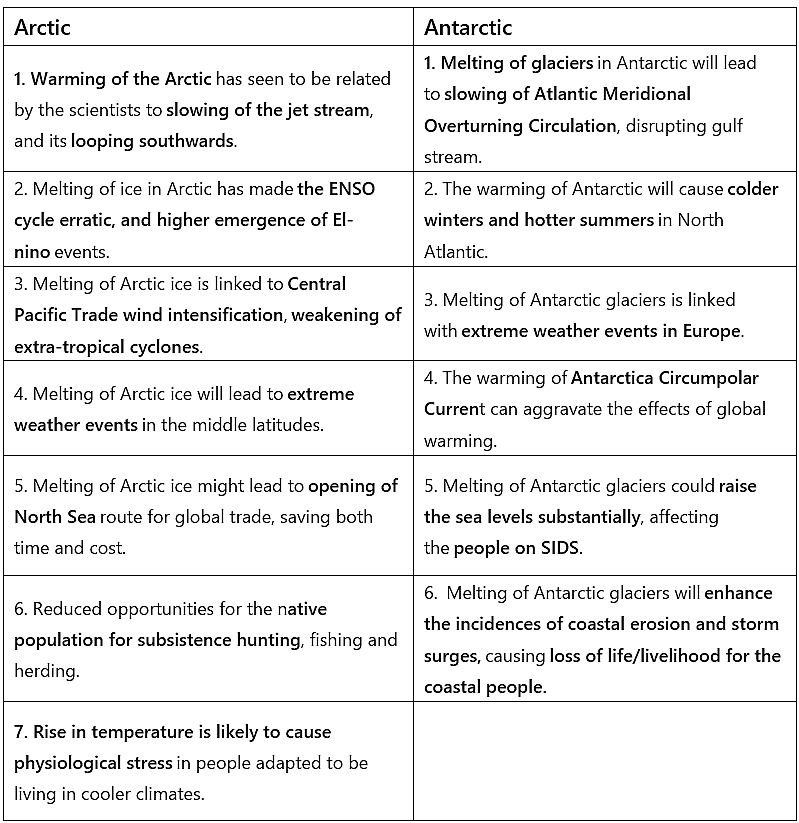GS1 PYQ (Mains Answer Writing): Oceanography | Geography for UPSC CSE PDF Download
Q1: How do the melting of the Arctic ice and glaciers of the Antarctic differently affect the weather patterns and human activities on the Earth? Explain. (UPSC GS1 Mains Paper)
Answer:
Arctic is an ocean covered by thin layers of perennial sea ice and surrounded by land while Antarctica is a continent covered by very thick ice cap. The melting of ice and glaciers in the two affects the weather pattern and human activities differently as seen below:
The melting of ice and glaciers in Arctic and Antarctic will have irreversible consequences for the humans as well as the global weather patterns. The need of the hour is to adopt sustainable approach to minimise the effects of global warming.
Q2: What are the forces that influence ocean currents? Describe their role in fishing industry of the world. (UPSC GS1 Mains Paper)
Answer:
Ocean currents can be likened to rivers flowing within the vast expanses of the sea. They consist of a consistent volume of water following a specific path and direction.
These currents are shaped by two distinct forces:
Primary Forces:
Solar Energy: The sun's heat causes water to expand, prompting movement from warmer to cooler regions.
Wind: Ocean-surface winds push the water, directing its flow.
Gravity: This force pulls water downward, creating gradient variations.
Coriolis Force: In the northern hemisphere, it steers water to the right, while in the southern hemisphere, it directs water to the left.
Secondary Forces:
Landmass: Interactions between oceans and land can alter current directions, as seen with the Brazil Ocean Current.
Salinity: Denser, saltier water sinks, whereas lighter water ascends, causing variations in currents.
These currents have significant implications for the fishing industry:
Fishing Zones Formation: The convergence of cold and warm currents creates prime fishing areas, such as the North East Pacific Zone and the North West Pacific Zone near Japan.
Upwelling: Driven by winds and Earth's rotation, this process brings nutrient-rich, cold water to the ocean's surface, promoting phytoplankton growth and attracting fish.
Plankton Movement: These current-borne organisms form the foundation of marine food chains, drawing fish to specific areas.
Product Longevity: Fish caught in colder currents tend to have extended shelf lives compared to those from warmer currents.
Ecological Balance: Currents help distribute water and maintain oxygen levels, ensuring balanced marine ecosystems. A case in point is the Saragasso Sea, a region rich in biodiversity.
While ocean currents play a pivotal role in shaping fishing zones, technological advancements offer opportunities to develop fisheries in other promising areas.
Q3: Why is India considered as a subcontinent? Elaborate your answer. (UPSC GS1 Mains Paper)
Answer:
The Indian subcontinent, a physiographic region in South Asia, is located on the Indian Plate and extends southward into the Indian Ocean from the Himalayas.
Geologically, the Indian subcontinent shares a connection with the landmass that separated from the supercontinent Gondwana during the Cretaceous period and fused with the Eurasian landmass approximately 55 million years ago. Geographically, it constitutes the peninsular region in South-Central Asia, bordered by the Himalayas to the north, the Hindu Kush to the west, and the Arakanese to the east.
This natural landmass in South Asia has been relatively isolated from the rest of Eurasia. The Himalayas (spanning from the Brahmaputra River in the east to the Indus River in the west), Karakoram (from the Indus River in the east to the Yarkand River in the west), and the Hindu Kush mountains (from the Yarkand River westwards) serve as its northern boundaries. The southern, south-eastern, and south-western boundaries are formed by the Indian Ocean, Bay of Bengal, and Arabian Sea.
Furthermore, India's substantial population and its diverse array of races, religions, castes, languages, and customs give it the appearance of a small continent within the subcontinent. This diversity is largely influenced by the physical characteristics of the land itself, shaping historical events like migrations and invasions. Despite numerous differences, there exist numerous similarities in the socio-cultural-economic way of life at the fundamental level.
|
175 videos|472 docs|197 tests
|
FAQs on GS1 PYQ (Mains Answer Writing): Oceanography - Geography for UPSC CSE
| 1. What is oceanography? |  |
| 2. Why is oceanography important? |  |
| 3. What are the different branches of oceanography? |  |
| 4. How do oceanographers collect data? |  |
| 5. What are some current challenges in oceanography? |  |

|
Explore Courses for UPSC exam
|

|

















